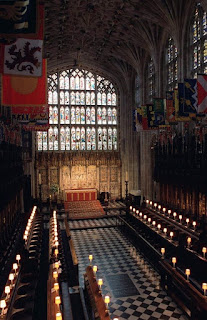 |
| Queen Jane Seymour by Hans Holbein |
On the evening of October 24, 1537, Jane Seymour, Queen of England and third wife of King Henry VIII, died. Only 11 days before, she had given birth to a son, Edward. While England was celebrating the birth of the young prince, everyone had thought Jane was going to be just fine. But late in the day on October 23, she developed a fever. And just 24 hours later, she was gone. There is no consensus on the cause of death: puerperal fever, massive bleeding, or was part of the placenta accidentally left inside her causing an infection. We just don’t know.
There’s a blog that I regularly follow that discusses all things Tudor. On the anniversary of Queen Jane’s death, there was the usual posting, but something about this year’s entry caught my attention. It said that after Jane’s death, Henry ordered that her heart and entrails be removed and buried separately under the altar in the Chapel Royal at Hampton Court Palace. Now, why I never knew about this little useless factoid before, I don’t know. But in this month where we like to read about such gruesome things, I thought I would do some poking around and see how common this was for British royalty.
 |
| The Chapel Royal, Hampton Court Palace |
What I found out is, this practice was rather typical, not just for British royals but for virtually all European royal houses. Because royals were not immediately buried, but rather paraded around the country or often would lie in state for weeks after death (Edward VI, Henry's son, wasn't buried for an entire month), embalmers had to be creative and would have to do certain things to slow down decomposition just a bit.
The practice involved cutting open the body, cleaning out the insides of the corpse, removing all the internal organs and such, wash the resultant body cavity with disinfectant, and then stuffing it with clean linens soaked in herbs, spices, and fragrant oils so the bodies wouldn't smell. In Queen Jane’s case, the heart and entrails were saved and buried separately. After three weeks of mourning, her corpse was buried in the choir at St George’s Chapel, Windsor Castle.
 |
| The choir at St George’s Chapel, Windsor Castle. |
The burial vault of St George’s Chapel was opened in 1813. This engraving shows the coffins of King Charles I (left), King Henry VIII (center), Queen Jane (right).
Links to further reading:
https://www.theanneboleynfiles.com/rip-queen-jane-seymour/
http://queryblog.tudorhistory.org/2009/06/question-from-kristian-jane-seymours.html
 |
| Coffins of King Charles I (left), King Henry VIII (center), Queen Jane (right). |
http://onthetudortrail.com/Blog/resources/tudor-tombs-and-burials/
http://royalcentral.co.uk/blogs/a-royal-burial-st-georges-chapel-25426
How's that for a Halloween story?










